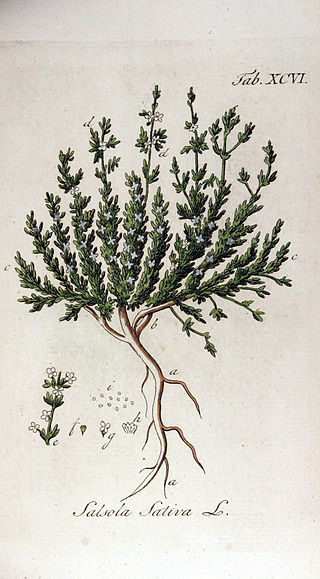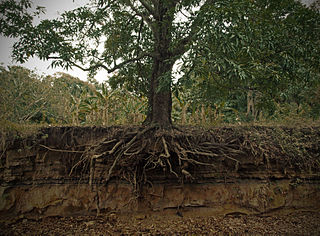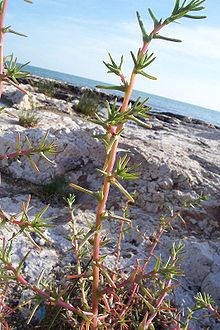In chemistry, an alkali is a basic, ionic salt of an alkali metal or an alkaline earth metal. An alkali can also be defined as a base that dissolves in water. A solution of a soluble base has a pH greater than 7.0. The adjective alkaline, and less often, alkalescent, is commonly used in English as a synonym for basic, especially for bases soluble in water. This broad use of the term is likely to have come about because alkalis were the first bases known to obey the Arrhenius definition of a base, and they are still among the most common bases.
Soda or SODA may refer to:

Natron is a naturally occurring mixture of sodium carbonate decahydrate (Na2CO3·10H2O, a kind of soda ash) and around 17% sodium bicarbonate (also called baking soda, NaHCO3) along with small quantities of sodium chloride and sodium sulfate. Natron is white to colourless when pure, varying to gray or yellow with impurities. Natron deposits are sometimes found in saline lake beds which arose in arid environments. Throughout history natron has had many practical applications that continue today in the wide range of modern uses of its constituent mineral components.

Sodium bicarbonate (IUPAC name: sodium hydrogencarbonate), commonly known as baking soda or bicarbonate of soda, is a chemical compound with the formula NaHCO3. It is a salt composed of a sodium cation (Na+) and a bicarbonate anion (HCO3−). Sodium bicarbonate is a white solid that is crystalline, but often appears as a fine powder. It has a slightly salty, alkaline taste resembling that of washing soda (sodium carbonate). The natural mineral form is nahcolite. It is a component of the mineral natron and is found dissolved in many mineral springs.

Sodium carbonate is the inorganic compound with the formula Na2CO3 and its various hydrates. All forms are white, odourless, water-soluble salts that yield alkaline solutions in water. Historically, it was extracted from the ashes of plants grown in sodium-rich soils, and because the ashes of these sodium-rich plants were noticeably different from ashes of wood, sodium carbonate became known as "soda ash". It is produced in large quantities from sodium chloride and limestone by the Solvay process, as well as by carbonating sodium hydroxide which is made using the Chlor-alkali process.
The Leblanc process was an early industrial process for making soda ash used throughout the 19th century, named after its inventor, Nicolas Leblanc. It involved two stages: making sodium sulfate from sodium chloride, followed by reacting the sodium sulfate with coal and calcium carbonate to make sodium carbonate. The process gradually became obsolete after the development of the Solvay process.
The Solvay process or ammonia–soda process is the major industrial process for the production of sodium carbonate (soda ash, Na2CO3). The ammonia–soda process was developed into its modern form by the Belgian chemist Ernest Solvay during the 1860s. The ingredients for this are readily available and inexpensive: salt brine (from inland sources or from the sea) and limestone (from quarries). The worldwide production of soda ash in 2005 was estimated at 42 million tonnes, which is more than six kilograms (13 lb) per year for each person on Earth. Solvay-based chemical plants now produce roughly three-quarters of this supply, with the remaining being mined from natural deposits. This method superseded the Leblanc process.
Saltwort is a common name for various genera of flowering plants that thrive in salty environments, typically in coastal salt marshes and seashores, including:

Halogeton is a plant genus of the family Amaranthaceae. The genus name, Halogeton, derives from the Greek words for "salt" and for "neighbor."
Alkali manufacture is the process by which an alkali is made. Typical alkalis, produced commercially, include sodium hydroxide, sodium carbonate, potassium hydroxide and potassium carbonate.

Soda inermis, the opposite-leaved saltwort, oppositeleaf Russian thistle, or barilla plant, is a small, annual, succulent shrub that is native to the Mediterranean Basin. It is a halophyte that typically grows in coastal regions and can be irrigated with salt water. The plant was previously classified as Salsola soda, and many of the sources for this article used that designation.

Salsola kali is the restored botanical name for a species of flowering plants in the amaranth family. It is native to the N.African and European Atlantic coasts to the Mediterranean. It is an annual plant which grows primarily in the temperate biome.

Halogeton sativus is a species of flowering plant in the family Amaranthaceae. It is native to Spain, Morocco and Algeria. Rich in salt, in the past it was cultivated to produce soda ash for glass-makers.

Alkali, or Alkaline, soils are clay soils with high pH, a poor soil structure and a low infiltration capacity. Often they have a hard calcareous layer at 0.5 to 1 metre depth. Alkali soils owe their unfavorable physico-chemical properties mainly to the dominating presence of sodium carbonate, which causes the soil to swell and difficult to clarify/settle. They derive their name from the alkali metal group of elements, to which sodium belongs, and which can induce basicity. Sometimes these soils are also referred to as alkaline sodic soils.
Alkaline soils are basic, but not all basic soils are alkaline.

The glassworts are various succulent, annual halophytic plants, that is, plants that thrive in saline environments, such as seacoasts and salt marshes. The original English glasswort plants belong to the genus Salicornia, but today the glassworts include halophyte plants from several genera, some of which are native to continents unknown to the medieval English, and growing in ecosystems, such as mangrove swamps, never envisioned when the term glasswort was coined.

Soda stocksii is a shrub species of the family Amaranthaceae.

Salicornia europaea, known as marsh samphire, common glasswort or just glasswort, is a halophytic annual dicot flowering plant in the family Amaranthaceae. Glasswort is a succulent herb also known as "pickle weed" or "marsh samphire". As a succulent, it has high water content, which accounts for its slightly translucent look and gives it the descriptive name "glasswort". To some people, it is known as "chicken toe" because of its shape. To others, it is called "saltwort". It grows in various zones of intertidal salt marshes, on beaches, and among mangroves.

The residual sodium carbonate (RSC) index of irrigation water or soil water is used to indicate the alkalinity hazard for soil. The RSC index is used to find the suitability of the water for irrigation in clay soils which have a high cation exchange capacity. When dissolved sodium in comparison with dissolved calcium and magnesium is high in water, clay soil swells or undergoes dispersion which drastically reduces its infiltration capacity.

Soda rosmarinus is a perennial-green desert species of saltwort in the Amaranthaceae family. It is endemic to the lower Jordan Valley along the Dead Sea, in Israel and Jordan, and in the Syrian desert, Central Iraq and in the coastal regions of Saudi Arabia, the islands of Bahrain, Qatar, and Iran, commonly known in Arabic by the names ʾušnān and šenān and in the Neo-Aramaic languages by reflexes of ʾuḥlā. It is often used by Bedouins for cleaning as a soap substitute. In medieval Arabic literature, it is also known by the names of "green ushnan" and "launderers' potash", having been used since time immemorial to produce nabulsi soap and as an electuary in compounding theriac for use in treating scorpion stings, as well as for extracting potassium for other medicinal uses.

Alkaline noodles, alkali noodles, or alkaline pasta is a variation of noodles with a much higher quantity of alkali than usual. The most common examples are Chinese lamian noodles and Japanese ramen noodles. The addition of alkali changes both the flavor and texture of the noodles, and makes them feel slippery in the mouth and on the fingers; they also develop a yellow color and are more elastic than ordinary noodles. Various flours such as ordinary all-purpose white flour, bread flour, and semolina flour can be used, with somewhat varying results. The yellow color is due to flavones that occur naturally in flour, which are normally colorless but turn yellow at alkaline pH.














